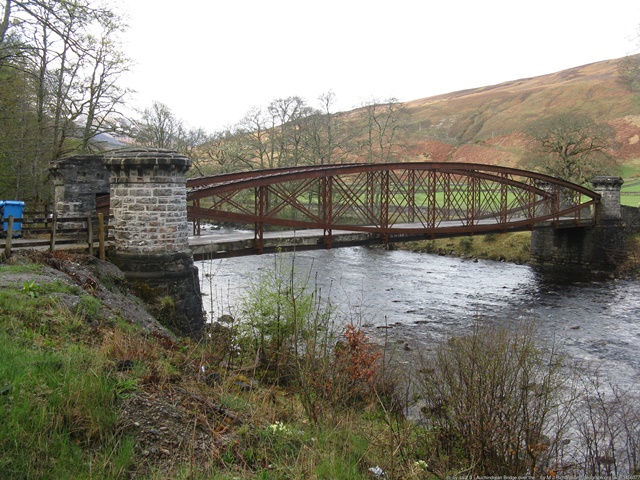We Recommend:
Bach Steel - Experts at historic truss bridge restoration.
BridgeHunter.com Phase 1 is released to the public! - Visit Now
Auchindrean Bridge

Primary Photographer(s): M J Richardson
Bridge Documented: May 14, 2018
Garve: Highland, Scotland: United Kingdom
By Builder/Contractor: Unknown and Engineer/Design: John Fowler
Not Available or Not Applicable
102.5 Feet (31.2 Meters)
102.5 Feet (31.2 Meters)
9 Feet (2.74 Meters)
1 Main Span(s)
Not Applicable

View Information About HSR Ratings
Bridge Documentation
Why would a simple driveway leading to a farm, and crossing a small river, feature such an elaborate design as a lenticular truss bridge? The answer is simple: Sir John Fowler lived here when the bridge was built. Certainly, one of the most famous bridge engineers in the United Kingdom (he was one of the engineers for the Forth Rail Bridge), would not be satisfied with a more simple and traditional bridge design! It is not known exactly when he had the bridge built however, but he bought the property in 1867, and the bridge is known to have existed by 1881, so a ca. 1870 construction date seems reasonable.
As such, this is the only known lenticular truss bridge in Scotland. The bridge retains integrity of design and materials.
Official Heritage Listing Information and FindingsListed At: Category A Discussion: Historic Environment Scotland Number: Sir John Fowler, circa 1870. Fine lenticular-truss wrought-iron bridge; wooden deck suspended from truss by lattice girders. Coursed rubble abutments extended upwards to form semi-circular approach piers with corbelled semi-circular caps. Statement of Special Interest Sir John Fowler bought Inverbroom Estate in 1867. For further notes see Corrieshalloc Gorge suspension bridge, Gairloch parish. Auchindrean bridge "unique in Scotland" (John Hume). Information From Canmore: This elegant, simply supported, iron truss bridge of
bowstring form, the only one of its kind in Scotland, was designed by or
under the direction of Sir John Fowler and may have been influenced
conceptually by I. K. Brunel’s Saltash Bridge. Fowler planned a bridge
of similar design for the Metropolitan Railway at Farringdon Road,
London, which was never built. Auchindrean Bridge has a span of 102 1/2
ft and a width of 9 ft. Its timber deck is suitable only for lightweight
vehicular traffic. It spans the Broom on an estate road leading to
Auchindrean Farm and existed before 1881. The masonry and steelwork
contractors are unknown to the authors. |
![]()
Photo Galleries and Videos: Auchindrean Bridge
Bridge Photo-Documentation
Original / Full Size PhotosA collection of overview and detail photos. This gallery offers photos in the highest available resolution and file size in a touch-friendly popup viewer.
Alternatively, Browse Without Using Viewer
![]()
Bridge Photo-Documentation
Mobile Optimized PhotosA collection of overview and detail photos. This gallery features data-friendly, fast-loading photos in a touch-friendly popup viewer.
Alternatively, Browse Without Using Viewer
![]()
Maps and Links: Auchindrean Bridge
Coordinates (Latitude, Longitude):
Search For Additional Bridge Listings:
Additional Maps:
Google Streetview (If Available)
GeoHack (Additional Links and Coordinates)
Apple Maps (Via DuckDuckGo Search)
Apple Maps (Apple devices only)
Android: Open Location In Your Map or GPS App
Flickr Gallery (Find Nearby Photos)
Wikimedia Commons (Find Nearby Photos)
Directions Via Sygic For Android
Directions Via Sygic For iOS and Android Dolphin Browser
Ordnance Survey Maps (UK Only)

